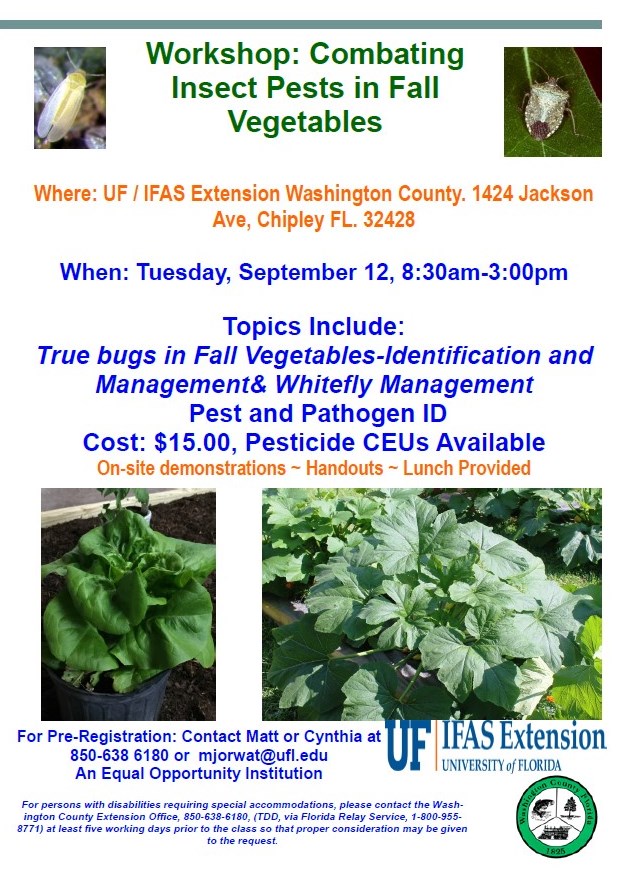
by Matthew Orwat | Aug 26, 2017
 This event has been cancelled due to Hurricane Irma and the impact it is having on the speakers, who were planning on travelling from central Florida. Rescheduled for February 2018
This event has been cancelled due to Hurricane Irma and the impact it is having on the speakers, who were planning on travelling from central Florida. Rescheduled for February 2018
Entomology specialists from the University of Florida and Extension agents will be leading hands on sessions focusing on insect pest management in vegetable production. This workshop is relevant to anyone growing vegetable crops in any season, but will have a special focus on fall vegetable pests.
Lunch will be provided and CEUs for pesticide license holders will also be available.
Cost: $ 15.00
Address: Washington County Ag Center East Wing, 1424 Jackson Ave, Chipley FL 32428.
Time: 8:30am-3:00pm
Pre Registration required for count: Contact Nikki or Cynthia at 850-638-6180 or email Matthew Orwat at mjorwat@ufl.edu
or register online at eventbrite HERE !
Agenda
-
Welcome and Introduction 8:30am-8:35 Matthew Orwat, Washington County Cooperative Extension, Amanda Hodges, University of Florida
-
True bugs in Fall Vegetables-Identification and Management 9:00am-10:15am
-
Cowpea Curculio 10:15am-10:30pm
-
Break 10:30am-10:45am
-
Whitefly Management 10:45am-11:10am
-
Invasive Species problems in North Florida Vegetable Production 11:10am-11:30am
-
Invasive Stink Bugs and Related True Bugs 11:30am-11:50pm
-
Lunch 11:50pm-12:30pm
-
Tomato leafminer Tuta absoltua 12:30m-12:45pm
-
Old World bollworm and Exotic Spodoptera Pests 12:45pm-1:05pm
-
Common Vegetable Plant Diseases in the Florida Panhandle 1:05pm-1:35pm
-
Pest and Pathogen Walk 1:35pm-2:05pm
-
CAPS Exotic Corn Diseases of Concern 2:05pm-2:35pm
-
Sample Submission, Arthropod and Disease samples 2:35pm-2:50p
by Daniel J. Leonard | Aug 25, 2017
Northwest Floridians are lucky. We get to bask in the warm sunshine at least eight months of the year, consider it cold weather when we have to break out the fleece pullover and none of us live more than a few hours’ drive to the whitest sand you ever saw. However, those conditions have consequences. That warm sun and plentiful rain yields heat and humidity, a perfect breeding ground for all manner of pests and diseases, not to mention seriously cutting down on necessary chill hours required by many species. We’ll never be able to grow peaches like they do in Georgia. No one is in any danger of mistaking a Florida apple for one from Michigan. Pomegranates, olives, and nectarines like California? Forget about it. All of those species will mostly survive and grow but in most cases, the inputs of labor and protective chemicals greatly outweigh the output of fruit. For most of us it is just not worth the time and effort to turn a crop!
We have a couple of adapted, well-known stalwarts to turn to though. Any gardener worth his salt has a few productive rabbiteye blueberries (Vaccinium ashei), a pear (Pyrus communis), an old reliable fig tree (Ficus carica), and a citrus or two of some kind (though with the devastating disease known as Citrus Greening looming on the horizon, backyard citrus may decline in popularity in the near future). However, hobby fruit growers aren’t often content to stick to those standards though. We tend to be an adventurous, progressive lot, always looking for new species to grow and constantly pushing climatic and adaptation limits of species, with varying success. For the Panhandle backyard fruit orchardist looking for a little variety but demanding a high probability of success, there are three unusual Florida Friendly trees requiring little winter chill that fit the bill perfectly: Pawpaw (Asimina triloba), Japanese Persimmon (Diospyros kaki), and Loquat (Eriobtrya japonica).
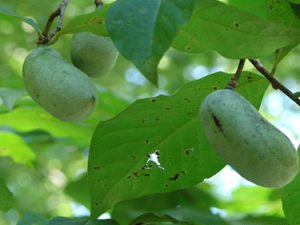
Pawpaw fruit
The pawpaw (yes it’s pronounced exactly like you think it is) is an altogether unusual tree. For starters, it is one of the most adaptable plants in cultivation, growing native from New York all the way down to the Sunshine State. It would be a beautiful tree if it never produced a single fruit; the large leaves droop naturally, lending a decidedly tropical feel to the garden and the understated purple-brown flowers are some of the more attractive of our native spring blooming trees. But, to be sure, the fruit are the real attraction here. Technically berries, the bluish-green, three to five inch long, oval-shaped fruit ripen in the late summer (August-October) and have an extremely unique taste often likened to banana or custard. Pawpaws occur naturally in moist, well-drained soils and thrive in both shade and sun; site accordingly and this unusual little native fruit tree should perform admirably for you!
While more common than Pawpaw, Japanese Persimmon still has not reached the cosmopolitan status of pear or fig or the like for reasons unclear to me! Native to eastern Asia, Japanese Persimmon is right at home in the Panhandle where it rewards gardeners each fall with outstanding reddish/orange foliage and a reliable crop of beautiful, baseball-sized, orange fruit possessing a crisp, sweet taste that can be eaten fresh or used in cooking. I especially like the fruit when it is made into a cakey “bread” similar to banana bread. It is a remarkably forgiving tree, growing and fruiting reliably with little help from the orchardist. Japanese Persimmon is generally sold as one of the selected cultivars, ‘Fuyu’ being the most common and probably the best. The species prefers full sun and moist, well-drained soil but does just fine without irrigation once it reaches establishment. A bonus, you only need to plant one as Japanese Persimmon does not require a pollinator! (Note: Persimmons can be astringent or non-astringent. If you plant an astringent cultivar, be sure to let the fruit ripen completely before eating as they are unpalatable until that point. Most are probably better off going with a non-astringent cultivar such as ‘Fuyu’.)
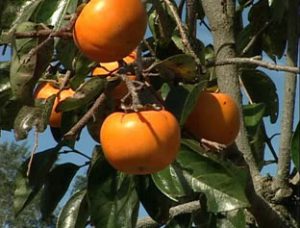
Persimmon fruit
A lesser-known gem of the coastal south, Loquat is hard to beat. It’s a great addition to the landscape, the cinnamon colored bark, foot-long “cabbagey” textured leaves and early spring flowers outdo many purely ornamental species. The yellowish-orange fruit that follow are outstanding picked and eaten fresh off the tree. Flavor is reminiscent of citrus with a sweet taste and a soft texture. Loquat flourishes in full sun and once established needs little to no supplemental fertilization or irrigation. As with Japanese Persimmon, Loquat is self-fertile and does not need a pollinator so just one tree will do (trust me, one healthy loquat will make enough fruit to feed a small army)!
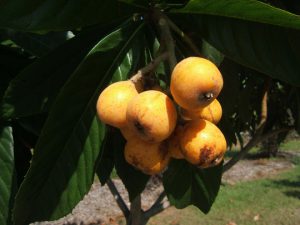
Loquat fruit
If you are indeed a backyard orcharding enthusiast and want to expand your horizons to include more than the same old standard species that everyone else grows or maybe you’re just frustrated with trying to grow popular but ill-adapted species like peach and apple, you could do a lot worse than including one or all of Pawpaw, Japanese Persimmon, and Loquat into your garden! For more information on fruit trees and any other horticultural questions you may have, contact your local UF/IFAS Extension office. Happy gardening!
by Matt Lollar | Aug 25, 2017
If you’ve attended any of our landscaping classes, then you’ve probably heard the phrase “Right Plant, Right Place”. This phrase is a simple reminder to research plant growth habits and growing conditions before making selections for your landscape. This not only holds true for ornamental plants, but for edible crops as well. A term used to describe the use of edibles as ornamentals is “Permaculture”. Now this is an extremely simplified definition of the term, but permaculture comes from a combination of the words “permanent” and “agriculture”. The thought behind permaculture is to fashion an edible landscape after a natural ecosystem.
There are a number of strategies to becoming a successful permaculturist. Below you will find a few examples.
- Site Observation and Analysis – The slope, orientation to the sun, and sectors of your yard should all be documented.
- Slope – Identifying the slope of your yard can help you determine the natural flow of water and nutrients. For example, if you have a hill in your back yard you may want to install some plant beds between the peak of the slope and your house. These beds will help absorb water and nutrients before they have a chance to reach the house.
- Orientation – Think about the location, relevant to your house, of each of your edible landscape areas. The eastern side of your house receives morning sunlight, which is much cooler than the western side of your house that receives sunlight in the afternoon. A tomato plant will be much happier if it can avoid the afternoon heat.
- Sectors – While walking your property, you will notice differences in soil texture, soil moisture, and the plants and weeds growing in these different areas. You can divide your yard based on these characteristics along with slope, orientation, and shade percentage to develop sectors of your property.
 Cover Crops and Living Mulch – Cover crops are planted in areas that you would normally allow to go fallow. Living mulches are plants that are planted alongside edible plants to help fill voids. The benefits of both are listed below.
Cover Crops and Living Mulch – Cover crops are planted in areas that you would normally allow to go fallow. Living mulches are plants that are planted alongside edible plants to help fill voids. The benefits of both are listed below.
- Weed Supression
- Erosion Control
- Produce and/or Scavenge Nutrients
- Nematode Supression
- Harbor Beneficial Insects
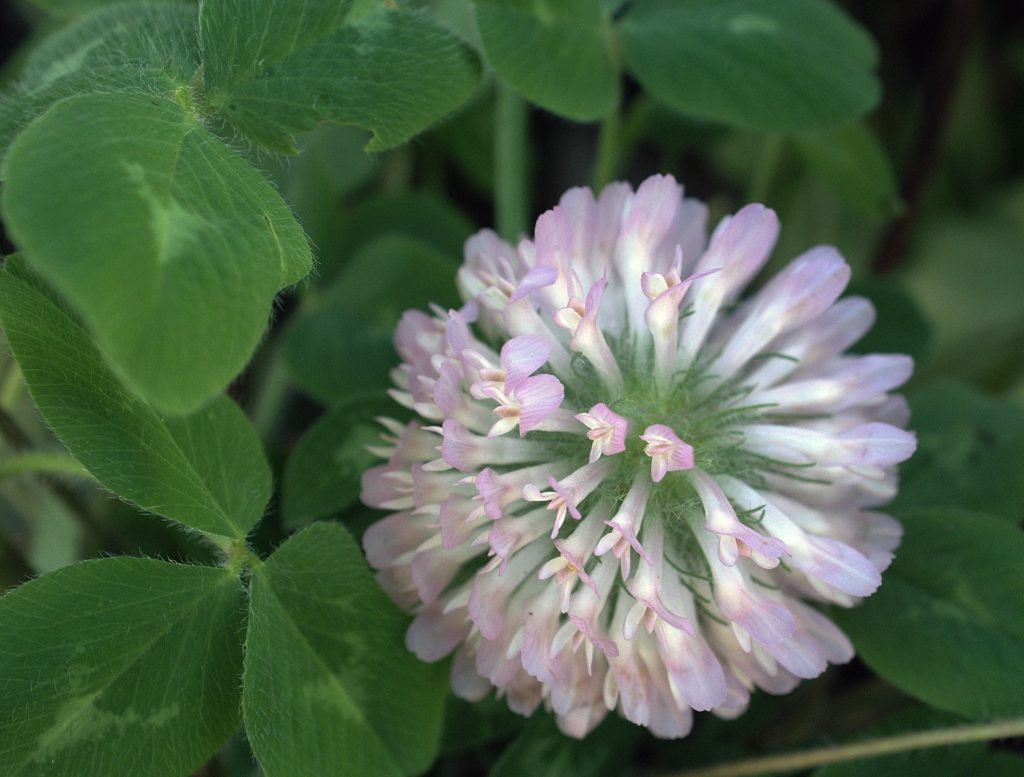
Clover is an excellent cover crop choice and has a beautiful flower. Photo Credit: University of Florida/IFAS.
- Space Utilization – The third criteria is to mimic a forest. Just like any good forest, your “forest garden” will consist of different layers of vegetation.
- You can start by planting large deciduous trees such as pecans or pears farthest from the house. These trees will allow filtered light to penetrate the layer below.
- Next, you can plant smaller fruit trees such as citrus or peaches along the understory of the larger trees.
- Then, you can plant your vegetable and herb garden around your fruit tree plantings.
- Finish by planting root and vining vegetables such as carrots or sweet potatoes at the edge of the forest.
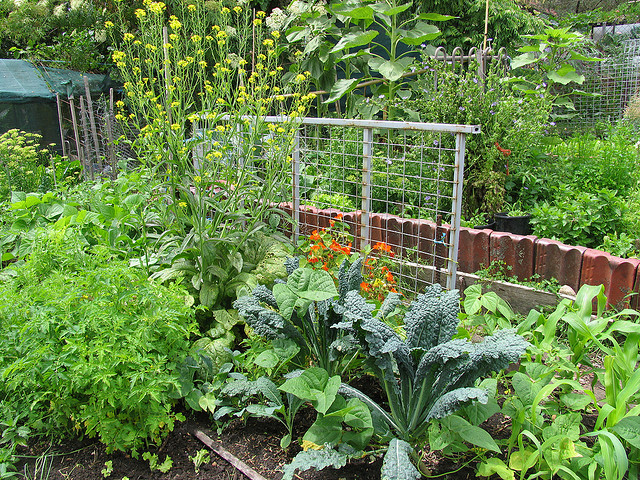
A mixed vegetable garden. Photo Credit: eXtension.org.
We’ve just scratched the surface of the concept of permaculture, but I encourage you to dig a little deeper. What could be the harm with being able to eat your landscape? Just don’t eat too much or you may lose your landscape entirely!
An “Intermediate Permaculture” class is scheduled for Saturday, September 23 at the Jackson County Extension Office. For more information, please call (850)-482-9620 and ask for Matt.
For more information on permaculture please visit the NC State Permaculture Page.
For more information on “Right Plant, Right Place” please visit the UF/IFAS Florida Friendly Living Site.
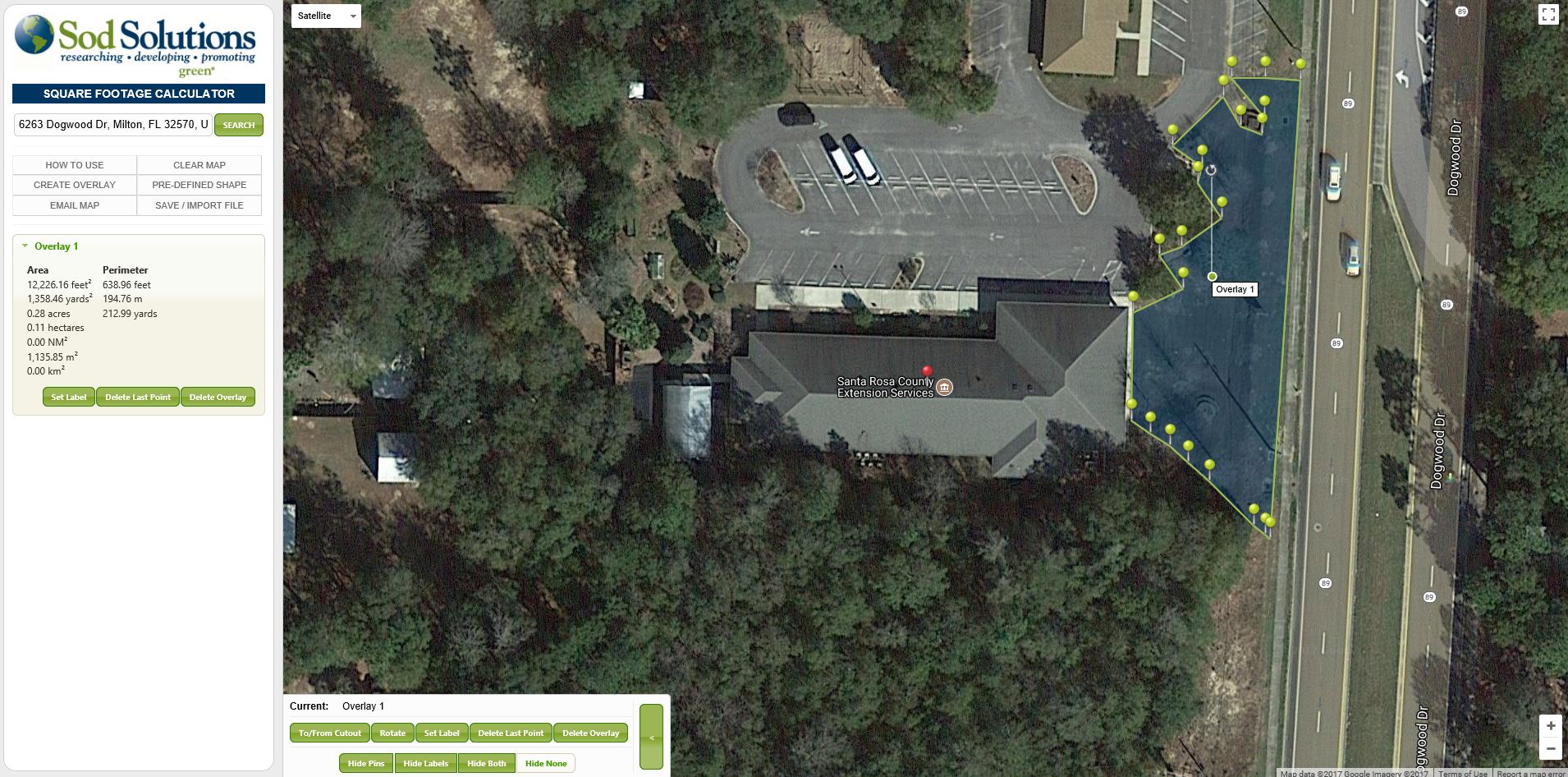
by Mary Salinas | Aug 25, 2017
After you have chosen the right fertilizer, fungicide, herbicide or insecticide to apply to your landscape, the question becomes: how much do I buy? Labels on these products will tell you how many square feet it will cover – so that leads to the next question: how many square feet of lawn do I have?
Here’s an easy way to determine your square footage. This online tool from Sod Solutions uses GIS mapping to figure it out from the comfort of your lounge chair.
On this front page, search for your address.

A bird’s eye view of your property comes up. Zoom in by using the + sign in the lower right corner of the screen.
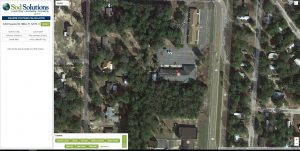
Plot points on the area you want to measure. This makes it so easy to measure those curved and odd-shaped areas!
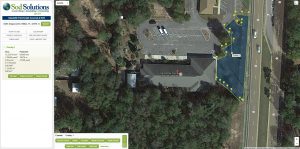
The calculation of the area in square feet, yards, and acres is displayed on the left side. The perimeter is also calculated; that might be handy for determining the length of a fence line.
For more information:
Your Florida Lawn website
The Florida Fertilizer Label
Interpreting Pesticide Label Wording
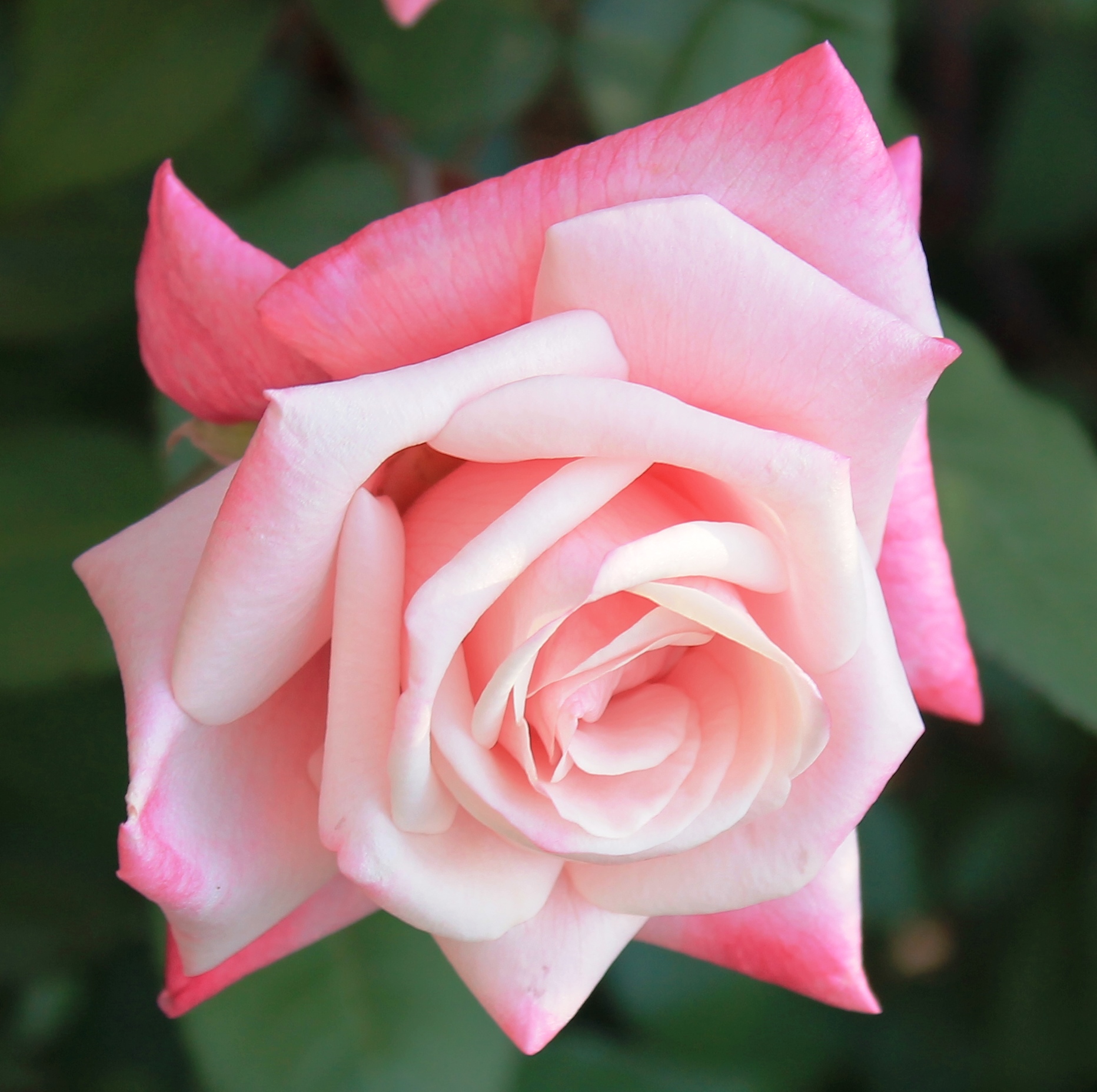
by Matthew Orwat | Aug 24, 2017
On Saturday, September 16th, 2017, from 9AM to 12PM, UF / IFAS Extension Washington County will be providing a rose gardening workshop for gardeners across the Panhandle. Many roses are hard to grow in the Florida Panhandle without investing considerable time and energy into spraying for insect and disease problems. This workshop will teach attendees how to select and sustainably grow roses adapted to the hot-humid conditions of the Southern Gulf Coast. There will be opportunities for outdoor learning and hands-on activities.
Topics include:
- Selection of disease resistant rose cultivars adapted to the lower South
- Resources to obtain hard to find easy care rose cultivars
- Soil and Nutrient Management
- Disease and insect management
- Irrigation
- Rose Propagation
Participants will be given the opportunity to propagate their own rose and take home their own propagation assembly to grow their own roses from scratch.
Refreshments will be provided and a door prize will be available.
Address: Washington County Ag Center Auditorium, 1424 Jackson Ave, Chipley FL 32428.
Pre Registration required for count: Contact Nikki or Cynthia at 850-638-6180 or email Matthew Orwat at mjorwat@ufl.edu
or register online at eventbrite HERE !
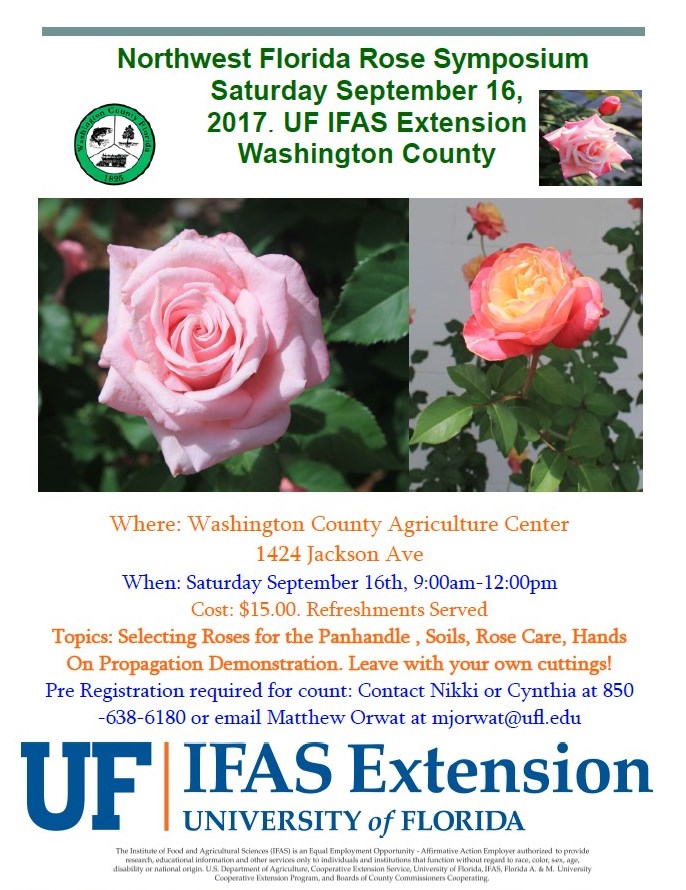

 This event has been cancelled due to Hurricane Irma and the impact it is having on the speakers, who were planning on travelling from central Florida. Rescheduled for February 2018
This event has been cancelled due to Hurricane Irma and the impact it is having on the speakers, who were planning on travelling from central Florida. Rescheduled for February 2018











